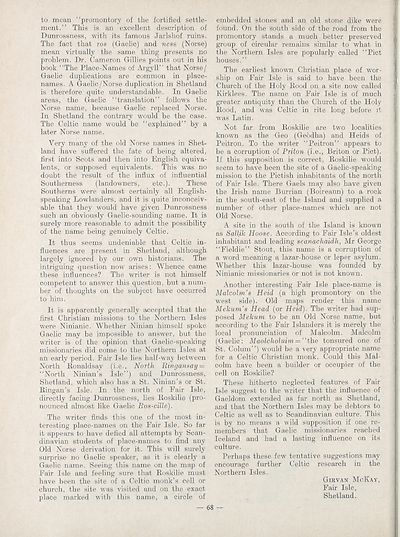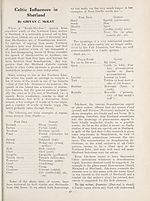An Comunn Gàidhealach Publications > Gaidheal > Volumes 58--62(part), January, 1963--March 1967
(496) Page 68
Download files
Complete book:
Individual page:
Thumbnail gallery: Grid view | List view

to mean “promontory of the fortified settle¬
ment.” This is an excellent description of
Dunrossness, with its famous Jarlshof ruins.
The fact that ros (Gaelic) and ness (Norse)
mean virtually the same thing presents no
problem. Dr. Cameron Gillies points out in his
book “The Place-Names of Argyll” that Norse/
Gaelic duplications are common in place-
names. A Gaelic/Norse duplication in Shetland
is therefore quite understandable. In Gaelic
areas, the Gaelic “translation” follows the
Norse name, because Gaelic replaced Norse.
In Shetland the contrary would be the case.
The Celtic name would be “explained” by a
later Norse name.
Very many of the old Norse names in Shet¬
land have suffered the fate of being altered,
first into Scots and then into English equiva¬
lents, or supposed equivalents. This was no
doubt the result of the influx of influential
Southerness (landowners, etc.). These
Southerns were almost certainly all English-
speaking Lowlanders, and it is quite inconceiv¬
able that they would have given Dunrossness
such an obviously Gaelic-sounding name. It is
surely more reasonable to admit the possibility
of the name being genuinely Celtic.
It thus seems undeniable that Celtic in¬
fluences are present in Shetland, although
largely ignored by our own historians. The
intriguing question now arises: Whence came
these influences? The writer is not himself
competent to answer this question, but a num¬
ber of thoughts on the subject have occurred
to him.
It is apparently generally accepted that the
first Christian missions to the Northern Isles
were Ninianic. Whether Ninian himself spoke
Gaelic may be impossible to answer, but the
writer is of the opinion that Gaelic-speaking
missionaries did come to the Northern Isles at
an early period. Fair Isle lies half-way between
North Ronaldsay (i.e., North Ringansay —
“North Ninian’s Isle”) and Dunrossness,
Shetland, which also has a St. Ninian’s or St.
Eingan’s Isle. In the north of Fair Isle,
directly facing Dunrossness, lies Eoskilie (pro¬
nounced almost like Gaelic Ros-cille).
The writer finds this one of the most in¬
teresting place-names on the Fair Isle. So far
it appears to have defied all attempts by Scan¬
dinavian students of place-names to find any
Old Norse derivation for it. This will surely
surprise no Gaelic speaker, as it is clearly a
Gaelic name. Seeing this name on the map of
Fair Isle and feeling sure that Eoskilie must
have been the site of a Celtic monk’s cell or
church, the site was visited and on the exact
place marked with this name, a circle of
embedded stones and an old stone dike were
found. On the south side of the road from the
promontory stands a much better preserved
group of circular remains similar to what in
the Northern Isles are popularly called “Piet
houses.”
The earliest known Christian place of wor¬
ship on Fair Isle is said to have been the
Church of the Holy Eood on a site now called
Kirklees. The name on Fair Isle is of much
greater antiquity than the Church of the Holy
Eood, and was Celtic in rite long before it
was Latin.
Not far from Eoskilie are two localities
known as the Geo (Geodha) and Heids of
Peitron. To the writer “Peitron” appears to
be a corruption of Priton (i.e., Briton or Piet).
If this supposition is correct, Eoskilie would
seem to have been the site of a Gaelic-speaking
mission to the Pictish inhabitants of the north
of Fair Isle. There Gaels may also have given
the Irish name Burrian (Boireann) to a rock
in the south-east of the Island and supplied a
number of other place-names which are not
Old Norse.
A site in the south of the Island is known
as Sallik Hoose. According to Fair Isle’s oldest
inhabitant and leading seanachaidh, Mr George
“Fieldie” Stout, this name is a corruption of
a word meaning a lazar-house or leper asylum.
Whether this lazar-house was founded by
Ninianic missionaries or not is not known.
Another interesting Fair Isle place-name is
Malcolm’s Heid (a high promontory on the
west side). Old maps render this name
Mekum’s Head (or Heid). The writer had sup¬
posed Mekum to be an Old Norse name, but
according to the Fair Islanders it is merely the
local pronunciation of Malcolm. Malcolm
(Gaelic: Maolcholuim = “the tonsured one of
St. Colum”) would be a very appropriate name
for a Celtic Christian monk. Could this Mal¬
colm have been a builder or occupier of the
cell on Eoskilie?
These hitherto neglected features of Fair
Isle suggest to the writer that the influence of
Gaeldom extended as far north as Shetland,
and that the Northern Isles may be debtors to
Celtic as well as to Scandinavian culture. This
is by no means a wild supposition if one re¬
members that Gaelic missionaries reached
Iceland and had a lasting influence on its
culture.
Perhaps these few tentative suggestions may
encourage further Celtic research in the
Northern Isles.
Girvan McKay,
Fair Isle,
Shetland.
ment.” This is an excellent description of
Dunrossness, with its famous Jarlshof ruins.
The fact that ros (Gaelic) and ness (Norse)
mean virtually the same thing presents no
problem. Dr. Cameron Gillies points out in his
book “The Place-Names of Argyll” that Norse/
Gaelic duplications are common in place-
names. A Gaelic/Norse duplication in Shetland
is therefore quite understandable. In Gaelic
areas, the Gaelic “translation” follows the
Norse name, because Gaelic replaced Norse.
In Shetland the contrary would be the case.
The Celtic name would be “explained” by a
later Norse name.
Very many of the old Norse names in Shet¬
land have suffered the fate of being altered,
first into Scots and then into English equiva¬
lents, or supposed equivalents. This was no
doubt the result of the influx of influential
Southerness (landowners, etc.). These
Southerns were almost certainly all English-
speaking Lowlanders, and it is quite inconceiv¬
able that they would have given Dunrossness
such an obviously Gaelic-sounding name. It is
surely more reasonable to admit the possibility
of the name being genuinely Celtic.
It thus seems undeniable that Celtic in¬
fluences are present in Shetland, although
largely ignored by our own historians. The
intriguing question now arises: Whence came
these influences? The writer is not himself
competent to answer this question, but a num¬
ber of thoughts on the subject have occurred
to him.
It is apparently generally accepted that the
first Christian missions to the Northern Isles
were Ninianic. Whether Ninian himself spoke
Gaelic may be impossible to answer, but the
writer is of the opinion that Gaelic-speaking
missionaries did come to the Northern Isles at
an early period. Fair Isle lies half-way between
North Ronaldsay (i.e., North Ringansay —
“North Ninian’s Isle”) and Dunrossness,
Shetland, which also has a St. Ninian’s or St.
Eingan’s Isle. In the north of Fair Isle,
directly facing Dunrossness, lies Eoskilie (pro¬
nounced almost like Gaelic Ros-cille).
The writer finds this one of the most in¬
teresting place-names on the Fair Isle. So far
it appears to have defied all attempts by Scan¬
dinavian students of place-names to find any
Old Norse derivation for it. This will surely
surprise no Gaelic speaker, as it is clearly a
Gaelic name. Seeing this name on the map of
Fair Isle and feeling sure that Eoskilie must
have been the site of a Celtic monk’s cell or
church, the site was visited and on the exact
place marked with this name, a circle of
embedded stones and an old stone dike were
found. On the south side of the road from the
promontory stands a much better preserved
group of circular remains similar to what in
the Northern Isles are popularly called “Piet
houses.”
The earliest known Christian place of wor¬
ship on Fair Isle is said to have been the
Church of the Holy Eood on a site now called
Kirklees. The name on Fair Isle is of much
greater antiquity than the Church of the Holy
Eood, and was Celtic in rite long before it
was Latin.
Not far from Eoskilie are two localities
known as the Geo (Geodha) and Heids of
Peitron. To the writer “Peitron” appears to
be a corruption of Priton (i.e., Briton or Piet).
If this supposition is correct, Eoskilie would
seem to have been the site of a Gaelic-speaking
mission to the Pictish inhabitants of the north
of Fair Isle. There Gaels may also have given
the Irish name Burrian (Boireann) to a rock
in the south-east of the Island and supplied a
number of other place-names which are not
Old Norse.
A site in the south of the Island is known
as Sallik Hoose. According to Fair Isle’s oldest
inhabitant and leading seanachaidh, Mr George
“Fieldie” Stout, this name is a corruption of
a word meaning a lazar-house or leper asylum.
Whether this lazar-house was founded by
Ninianic missionaries or not is not known.
Another interesting Fair Isle place-name is
Malcolm’s Heid (a high promontory on the
west side). Old maps render this name
Mekum’s Head (or Heid). The writer had sup¬
posed Mekum to be an Old Norse name, but
according to the Fair Islanders it is merely the
local pronunciation of Malcolm. Malcolm
(Gaelic: Maolcholuim = “the tonsured one of
St. Colum”) would be a very appropriate name
for a Celtic Christian monk. Could this Mal¬
colm have been a builder or occupier of the
cell on Eoskilie?
These hitherto neglected features of Fair
Isle suggest to the writer that the influence of
Gaeldom extended as far north as Shetland,
and that the Northern Isles may be debtors to
Celtic as well as to Scandinavian culture. This
is by no means a wild supposition if one re¬
members that Gaelic missionaries reached
Iceland and had a lasting influence on its
culture.
Perhaps these few tentative suggestions may
encourage further Celtic research in the
Northern Isles.
Girvan McKay,
Fair Isle,
Shetland.
Set display mode to:
![]() Universal Viewer |
Universal Viewer | ![]() Mirador |
Large image | Transcription
Mirador |
Large image | Transcription
| An Comunn Gàidhealach > An Comunn Gàidhealach Publications > Gaidheal > Volumes 58--62(part), January, 1963--March 1967 > (496) Page 68 |
|---|
| Permanent URL | https://digital.nls.uk/127154733 |
|---|
| Description | This contains items published by An Comunn, which are not specifically Mòd-related. It includes journals, annual reports and corporate documents, policy statements, educational resources and published plays and literature. It is arranged alphabetically by title. |
|---|
| Description | A collection of over 400 items published by An Comunn Gàidhealach, the organisation which promotes Gaelic language and culture and organises the Royal National Mòd. Dating from 1891 up to the present day, the collection includes journals and newspapers, annual reports, educational materials, national Mòd programmes, published Mòd literature and music. |
|---|---|
| Additional NLS resources: |
|

